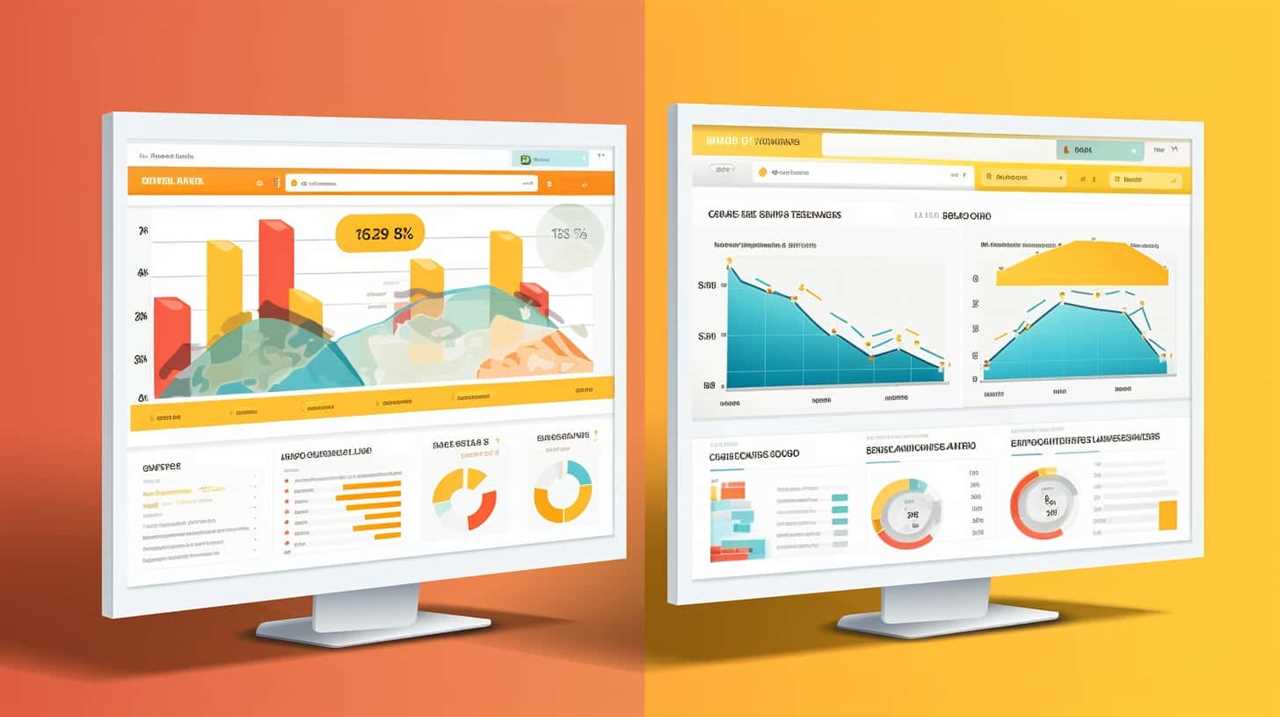Keyword Research
Which Website Characteristics Are Also Considered Technical Seo Ranking Factors

Ever wondered why some websites pop up first on search engine results?
Well, we’re here to shed some light on the matter. In this article, we’ll discuss the website characteristics that are also considered technical SEO ranking factors.
These factors, including website speed, mobile-friendliness, site architecture, URL structure, crawlability, and structured data markup, play a crucial role in determining how well a website performs in search rankings.
So, let’s dive in and discover the key ingredients for SEO success.

Key Takeaways
- Website speed and mobile-friendliness are crucial technical SEO ranking factors.
- Site architecture and navigation usability play a significant role in user experience and SEO rankings.
- URL structure and optimization are important for improving visibility and click-through rates.
- Proper implementation of URL redirects and structured data markup can enhance crawlability, indexability, and user experience.
Website Speed
Website speed is an essential technical SEO ranking factor that affects user experience and search engine visibility.
To optimize website load time, it’s crucial to focus on improving server response time. The faster your website loads, the better the user experience, leading to increased engagement and lower bounce rates.
Additionally, search engines prioritize websites with faster load times, resulting in improved rankings and visibility.
To achieve website load time optimization, consider optimizing images and files, reducing HTTP requests, and leveraging browser caching.

By improving server response time, your website will deliver content more efficiently, ultimately enhancing user satisfaction and SEO performance.
Now let’s transition to the next section, where we’ll discuss the importance of mobile-friendliness in technical SEO ranking factors.
Mobile-Friendliness
Now let’s delve into the importance of ensuring that your site is mobile-friendly, as it directly impacts technical SEO ranking factors.
In today’s digital landscape, with the increasing use of smartphones and tablets, having a mobile-friendly website is crucial for success. Responsive design is key in making sure your site adapts and displays properly on different devices, providing a seamless user experience.

A mobile-friendly website not only improves user satisfaction but also contributes to your site’s overall SEO performance. Google considers mobile user experience as a ranking factor, meaning that if your site isn’t optimized for mobile, it may be penalized in search rankings. Therefore, it’s essential to prioritize mobile-friendliness in order to improve your technical SEO and attract more organic traffic.
Site Architecture
When it comes to site architecture, there are several key points to consider for SEO purposes.
One important aspect is the URL structure, as it plays a role in how search engines understand and categorize your website.
Additionally, navigation usability is crucial to ensure that both users and search engines can easily navigate through your site.

URL Structure Importance
We can’t underestimate the impact of a well-structured URL on our site’s technical SEO ranking factors. A clean URL structure offers significant SEO benefits, helping search engines and users understand the content of our webpages. It improves the user experience by providing clear and descriptive URLs that are easy to read and remember. Moreover, a clean URL structure enhances the crawlability and indexability of our website, making it easier for search engines to discover and rank our pages. On the other hand, URL length plays a crucial role in SEO performance. Long and complex URLs can negatively affect our rankings, as they may be perceived as spammy or less trustworthy. Therefore, it is essential to keep our URLs concise, relevant, and keyword-focused.
| URL Structure Importance | |
|---|---|
| Benefits of Clean URL Structure | Impact of URL Length |
| – Enhances user experience | – Long URLs can be spammy |
| – Improves crawlability and indexability | – Complex URLs may appear less trustworthy |
| – Helps search engines understand content | – Short, concise URLs are preferred |
| – Easy to read and remember | – Keyword-focused URLs are more effective |
Navigation Usability and SEO
One crucial aspect of technical SEO ranking factors is the navigation usability and site architecture.
When it comes to user experience metrics, a well-designed site architecture can greatly impact how users navigate your website. A clear and intuitive navigation menu can make it easier for users to find the information they’re looking for, leading to longer visit durations and lower bounce rates.
Additionally, a well-structured site architecture can improve internal linking strategies, which are important for SEO. By strategically linking relevant pages within your website, you can help search engines understand the hierarchy and importance of your content. This can ultimately lead to better crawlability, indexation, and overall SEO performance.

Therefore, optimizing your navigation usability and site architecture is essential for improving both user experience and SEO rankings.
URL Structure
When it comes to URL structure, there are a few key points to consider for SEO ranking factors.
First, it’s important to have SEO-friendly URLs that are easy to read and understand by both search engines and users.
Second, optimizing keywords in the URLs can help improve the relevance and visibility of your website in search results.

Lastly, using proper URL redirects ensures that users and search engines are directed to the correct page, minimizing the potential for broken links and improving user experience.
SEO-friendly URLs
Although often overlooked, SEO-friendly URLs play a crucial role in improving a website’s technical SEO ranking factors. The impact of URL structure on search engine rankings can’t be underestimated.
Here are four URL optimization techniques that can enhance your website’s visibility:
- Use descriptive keywords: Incorporate relevant keywords in your URLs to give search engines an idea of what your page is about.
- Keep it concise: Shorter URLs are easier for users to remember and share. Avoid long, convoluted URLs that can confuse both search engines and users.
- Use hyphens instead of underscores: Search engines treat hyphens as word separators, making it easier to read and understand the URL structure.
- Avoid dynamic parameters: Clean URLs without unnecessary parameters are preferred by search engines, as they’re more user-friendly and easier to index.
Implementing these URL optimization techniques can enhance your website’s technical SEO ranking factors and improve its visibility in search engine results.

Keyword Optimization in URLs
To continue our discussion on URL optimization techniques, we’ll now explore the importance of keyword optimization in URLs for improving a website’s technical SEO ranking factors.
Keyword optimization in URLs involves incorporating relevant keywords into the structure of the URL to enhance content relevancy and improve user experience optimization.
When search engines crawl a website, they analyze the URL structure to understand the content and context of the page. By including targeted keywords in the URL, you can signal to search engines the relevance of your content and increase the chances of ranking higher in search results.
Additionally, keyword-optimized URLs make it easier for users to understand what the page is about and can improve click-through rates.

Therefore, it’s essential to carefully craft your URLs with relevant keywords to maximize your website’s technical SEO ranking factors.
Proper URL Redirects
One important factor to consider for technical SEO ranking is the proper implementation of URL redirects within the website’s structure.
Here are some key points to keep in mind when it comes to handling URL redirects:
- Impact of 301 vs 302 redirects on SEO rankings: It’s crucial to choose the appropriate redirect type. A 301 redirect is a permanent redirect that signals to search engines that the original URL has permanently moved to a new location. This transfer of authority helps preserve the SEO value of the original page. On the other hand, a 302 redirect is a temporary redirect that indicates the original URL is temporarily moved, and search engines may not transfer the SEO value to the new URL.
- Best practices for handling URL redirects during website migrations: During website migrations, it’s important to plan and execute proper URL redirects to ensure a smooth transition. This involves mapping old URLs to new ones, redirecting each old URL to its corresponding new URL, and testing the redirects to ensure they’re working correctly. Additionally, it’s advisable to update internal links, XML sitemaps, and canonical tags to reflect the new URL structure.
Crawlability and Indexability
For effective technical SEO ranking, ensuring crawlability and indexability of a website is crucial. Crawlability refers to the ability of search engines to access and navigate through a website’s pages. Indexability refers to the inclusion of web pages in search engine indexes.

To improve crawlability and indexability, it’s important to use canonical tags. These tags help search engines understand the preferred version of a webpage when there are multiple URLs with similar content. Canonical tags are essential for preventing duplicate content issues and ensuring that the correct page is indexed.
Another factor that affects crawlability is the robots.txt file. This file instructs search engine crawlers on which parts of the website should or shouldn’t be crawled.
By optimizing these factors, websites can improve their crawlability and indexability, leading to better search engine visibility.
Now, let’s delve into the next topic: structured data markup.

Structured Data Markup
Now that we’ve covered the importance of crawlability and indexability, let’s move on to the next crucial aspect of technical SEO ranking: structured data markup.
Structured data markup refers to the implementation of code that helps search engines understand the content of a webpage. Here are four key points to keep in mind when it comes to structured data markup:
- Rich snippets optimization: Rich snippets are enhanced search results that provide extra information about a webpage. By optimizing your structured data markup, you can increase the chances of your website appearing with rich snippets in search engine results, which can improve click-through rates and visibility.
- Schema markup implementation: Schema markup is a specific type of structured data markup that uses a standardized vocabulary to provide context and meaning to the content on a webpage. Implementing schema markup can help search engines better understand your website’s content and improve its visibility in search results.
- Increased organic visibility: By incorporating structured data markup, you can potentially enhance your website’s organic visibility in search engine results. This is because structured data provides additional information to search engines, allowing them to display more relevant and detailed search results for users.
- Improved user experience: Structured data markup not only benefits search engines but also improves the user experience. By providing more accurate and comprehensive information in search results, users can make more informed decisions about which website to visit. This can lead to higher engagement, lower bounce rates, and increased conversions.
Incorporating structured data markup into your website is a crucial step in optimizing your technical SEO. By implementing rich snippets optimization and schema markup, you can improve your website’s visibility, organic traffic, and user experience.
Frequently Asked Questions
How Does Website Speed Impact Search Engine Rankings?
Website speed plays a crucial role in search engine rankings. A slow-loading website can negatively impact user experience, leading to higher bounce rates and lower conversions. It also affects crawlability, making it harder for search engines to index your pages effectively.

Optimizing website design and improving site speed can result in better rankings and increased organic traffic. Therefore, it’s essential to prioritize website speed as a technical SEO ranking factor.
What Are the Key Elements of a Mobile-Friendly Website?
When it comes to a mobile-friendly website, responsive design and mobile usability are key elements.
A responsive design ensures that the website adapts and functions properly on different devices.
Mobile usability focuses on providing a seamless user experience on mobile devices.

These factors are crucial because a large number of internet users access websites on their mobile devices.
Ensuring a mobile-friendly experience can improve user satisfaction and potentially boost search engine rankings.
How Does Site Architecture Affect SEO Performance?
Site architecture plays a crucial role in SEO performance. It directly impacts user engagement and crawlability.
A well-structured site architecture makes it easier for search engines to crawl and index your content, improving your chances of ranking higher in search results. It also enhances user experience by allowing visitors to navigate your site more easily.

What Are the Best Practices for Optimizing URL Structure for Seo?
Optimizing URL structure is crucial for SEO success. We can achieve this by following the best practices for keyword research and understanding the importance of meta tags in SEO optimization.
A well-structured URL helps search engines understand the content of the page, making it easier for them to crawl and index your website.
How Does the Presence of Structured Data Markup Influence Search Engine Rankings?
The presence of structured data markup, like schema markup, can have a significant impact on search engine rankings. By using rich snippets and providing additional information about your content, you can increase visibility and attract more targeted traffic.
Schema markup helps search engines understand the context and meaning of your content, resulting in higher rankings and improved click-through rates. Implementing structured data markup is one of the best practices for optimizing SEO and can provide numerous benefits for your website.

Conclusion
In our journey through the world of website characteristics, we’ve discovered the hidden treasures of technical SEO ranking factors.
Just like the wind guides a ship to its destination, website speed, mobile-friendliness, site architecture, URL structure, crawlability, and indexability act as guiding beacons for search engines.
And like a map that leads us to our desired location, structured data markup helps search engines understand and appreciate the content on our websites.
By embracing these factors, we can set sail towards higher rankings and greater online success.

Keyword Research
4 Best Keyword Research Tips for Creative Industries

Having trouble finding the perfect keywords for your art field? Search no more! Our top four tips for conducting keyword research provide all the information you need.
Understanding your target audience is key, so let’s dive in and brainstorm relevant keywords.
Don’t forget to utilize powerful keyword research tools to enhance your strategy.
And finally, analyze and refine your keyword list to ensure optimal results.
Get ready to master the art of keyword research in the creative world!
Key Takeaways
- Understanding the target audience is crucial in keyword research for creative industries.
- Brainstorming relevant keywords can be done through competitor analysis, customer feedback, industry trends, and social media.
- Keyword research tools provide valuable insights and data, helping uncover hidden opportunities and understand customer intent.
- Analyzing and refining the keyword list by incorporating long tail and localized keywords can maximize SEO efforts in creative industries.
Understand Your Target Audience
In this article, we’ll explore the importance of understanding our target audience in conducting effective keyword research for creative industries.
Understanding consumer behavior and identifying market trends are crucial steps in developing a successful keyword strategy. By gaining insights into our target audience, we can tailor our keywords to align with their preferences and needs. This understanding allows us to create content that resonates with our audience and drives relevant traffic to our websites.
By analyzing consumer behavior, such as their search patterns and preferences, we can identify the keywords that are most likely to attract our target audience. Additionally, staying updated on market trends helps us anticipate changes in consumer demand and adjust our keyword strategy accordingly.
Ultimately, understanding our target audience is the foundation of effective keyword research in creative industries.
Brainstorm Relevant Keywords
To effectively brainstorm relevant keywords for creative industries, we need to collaborate and explore various ideas as a team. Keyword expansion techniques and long tail keyword opportunities can help us expand our keyword list and target a wider range of potential customers.
Here are four strategies to consider:
- Conduct competitor analysis: Study the keywords used by your competitors to gain insights and identify new keyword possibilities.
- Use customer feedback: Review customer reviews, comments, and inquiries to uncover keywords that reflect their needs and interests.
- Analyze industry trends: Stay up-to-date with the latest trends in your creative industry and incorporate relevant keywords into your list.
- Leverage social media: Monitor social media conversations related to your industry to discover popular keywords and phrases.
By implementing these strategies, we can generate a comprehensive list of relevant keywords that will enhance our online visibility and attract our target audience.
Now, let’s explore how we can use keyword research tools to refine our keyword selection and maximize our SEO efforts.
Use Keyword Research Tools
Now let’s explore how we can leverage keyword research tools to further enhance our keyword selection and maximize our SEO efforts in the creative industries.
Keyword research tools provide valuable insights and data that can help us identify the most relevant and high-performing keywords for our artistic industries and design businesses. These tools offer features such as keyword suggestions, search volume data, competition analysis, and trend tracking.
By using these tools, we can uncover hidden opportunities, understand customer intent, and optimize our website content accordingly. Additionally, keyword research tools enable us to stay updated with the latest trends and search patterns in our industries, allowing us to adapt our SEO strategies accordingly.
Analyze and Refine Your Keyword List
Now, let’s delve into analyzing and refining our keyword list to ensure that we’re targeting the most effective and relevant keywords for our creative industries.
To optimize our keyword list, we should focus on incorporating long tail keywords. These are specific keyword phrases that are more likely to attract our target audience and have less competition. By including these long tail keywords, we can increase our chances of ranking higher on search engine result pages.
Additionally, it’s crucial to incorporate localized keywords for targeted marketing. This means including keywords that are specific to our target geographic location, helping us reach potential customers in our area.
Frequently Asked Questions
How Can I Effectively Use Social Media to Research Keywords for My Creative Industry?
To effectively use social media for keyword research in our creative industry, we leverage influencer collaborations and utilize user-generated content. These strategies provide valuable insights into the keywords that resonate with our target audience and drive engagement.
Are There Any Specific Techniques or Strategies to Find Long-Tail Keywords in the Creative Industry?
When finding niche keywords, it’s important to consider the value of long-tail keywords in the creative industry. We can employ specific techniques and strategies to uncover these valuable keywords for maximum impact and success.
What Are Some Common Mistakes to Avoid When Conducting Keyword Research for Creative Industries?
When it comes to keyword research for creative industries, avoiding common mistakes is crucial. By understanding how to avoid keyword research pitfalls in the creative industry, we can optimize our strategies and achieve mastery.
How Can I Ensure That My Keyword Research Aligns With Current Trends in the Creative Industry?
To ensure our keyword research aligns with current trends in the creative industry, we emphasize the importance of data analysis and staying ahead of the competition by identifying emerging trends.
Are There Any Alternative Keyword Research Methods That Are Specific to the Creative Industry?
Yes, there are alternative keyword research tools tailored specifically to the unique challenges of the creative industry. These tools can help us uncover trending keywords and optimize our content for maximum visibility.
How Can Holistic SEO Benefit Fashion Designers?
Holistic seo strategies for fashion designers can greatly benefit their online presence and overall brand success. By implementing these strategies, designers can ensure their website is optimized for search engines, driving organic traffic and increasing visibility. From keyword research and on-page optimization to holistic link building and content creation, fashion designers can establish a strong online presence, reaching their target audience effectively. Ultimately, holistic SEO strategies contribute to higher website rankings, brand authority, and increased sales for fashion designers.
Conclusion
In the world of creative industries, understanding your target audience and using relevant keywords is crucial for success. By utilizing keyword research tools and analyzing your keyword list, you can refine your content to reach the right audience.
Remember, keywords are like a secret language that connects you with your desired audience, so choose them wisely.
With these tips, you can unlock the door to reaching and captivating your target audience, leading to greater success in the creative industries.
Keyword Research
How to Keyword Search Excel

Struggling to locate specific data in Excel? You’re in the right place!
In this article, we will guide you through the process of keyword searching in Excel. We will show you how to utilize the search function effectively, employ advanced options, and use filters to refine your search results.
Additionally, we will share tips and tricks, including the use of macros, to enhance your keyword searching skills.
Get ready to master Excel’s search capabilities!
Key Takeaways
- Excel’s search function allows users to quickly find and navigate through large amounts of data.
- Utilizing advanced search options like wildcards, match case, and search by format enhances the process of finding specific keywords within a spreadsheet.
- Applying filters in Excel allows users to specify criteria to determine which rows of data are displayed, narrowing down search results.
- Employing macros in Excel streamlines the keyword searching process, automating it and saving time and effort.
Understanding Excel’s Search Function
In this section, we’ll explore the functionality of Excel’s search function and how it can be used to efficiently locate specific keywords within a spreadsheet.
Excel’s search function is a powerful tool that allows users to quickly find and navigate through large amounts of data.
One useful feature of the search function is the ability to use wildcard characters. Wildcard characters, such as the asterisk (*) and question mark (?), can be used to represent unknown or variable characters in a keyword search. This can greatly enhance the search capabilities and flexibility in Excel.
Another efficient way to search for keywords in Excel is by utilizing the ‘Find and Replace’ feature. This feature allows users to not only find specific keywords, but also replace them if needed.
Utilizing Advanced Search Options in Excel
To effectively utilize advanced search options in Excel, we can employ various techniques to streamline the process of finding specific keywords within a spreadsheet. Here are three key ways to leverage these advanced search options:
- Excel’s search function: Excel’s search function allows users to search for keywords within a single sheet. Compared to other spreadsheet software, Excel provides a more robust and efficient search functionality.
- Searching in multiple sheets: Excel also enables users to search for keywords in multiple sheets. This feature is particularly useful when working with large datasets spread across multiple sheets, as it allows for a comprehensive search across the entire workbook.
- Advanced search options: Excel offers advanced search options like wildcards, match case, and search by format. These options allow users to refine their searches and find specific keywords with greater precision.
Using Filters to Narrow Down Search Results in Excel
We can further narrow down search results in Excel by applying filters. Filtering data in Excel allows us to specify criteria that will determine which rows of data are displayed. By using filters, we can easily find and analyze specific information within a large dataset.
To apply a filter in Excel, follow these steps:
- Select the range of data you want to filter.
- Go to the Data tab and click on the Filter button.
- A dropdown arrow will appear next to each column header. Click on the arrow to display the filter options for that column.
Using filters in Excel gives us the ability to search for specific values, text, or even patterns using wildcards. Wildcards are special characters that represent unknown or variable characters. For example, the asterisk (*) can be used to represent any number of characters, while the question mark (?) represents a single character. By using wildcards in Excel search, we can further refine our filters and find exactly what we’re looking for.
Employing Macros for Efficient Keyword Searching in Excel
When using filters to narrow down search results in Excel, we can further enhance our keyword searching efficiency by employing macros. Customizing search settings in Excel allows us to tailor our search criteria to specific needs, such as searching within a range of cells or ignoring case sensitivity.
Automating keyword search using VBA macros eliminates the need for manual searching, saving time and effort. With macros, we can set up automated processes to search for keywords across multiple worksheets or workbooks, generating instant results.
By using macros, we can streamline our keyword searching process and ensure accurate and efficient results.
In the next section, we’ll discuss some tips and tricks for effective keyword search in Excel, building upon the techniques we’ve already explored.
Tips and Tricks for Effective Keyword Search in Excel
How can we further enhance our keyword searching efficiency in Excel?
One way is by using wildcard characters for more precise keyword searches. Wildcards are special characters that represent unknown or variable characters in a search string. For example, the asterisk (*) represents any number of characters, while the question mark (?) represents a single character. By incorporating these wildcard characters into our search queries, we can broaden or narrow down our search results as needed.
Another technique to consider is creating custom search formulas in Excel. These formulas allow us to specify specific keywords or conditions to search for within our data. For instance, we can use the COUNTIF function to count the number of occurrences of a particular keyword in a range of cells. By utilizing these custom search formulas, we can quickly and accurately locate the information we need.
Frequently Asked Questions
Can I Search for Specific Formatting Options, Such as Bold or Italicized Text, in Excel Using Keyword Search?
Yes, we can use advanced search options in Excel to find specific formatting styles like bold or italicized text. We can also use wildcard characters in keyword searches to refine our search results.
Is It Possible to Search for Keywords Within Only a Specific Range of Cells in Excel?
Yes, it is possible to search for keywords within a specific range of cells in Excel. By using advanced filtering techniques and incorporating wildcard characters, you can enhance your keyword searches for more precise results.
How Can I Search for Keywords in Excel and Have the Search Results Display in a Separate Sheet?
We can use advanced filtering techniques in Excel to search for keywords and display the results in a separate sheet. Additionally, we can automate this process using VBA macros for efficient and seamless keyword searching.
Can I Search for Keywords in Excel and Have the Search Results Automatically Update as New Data Is Added?
Yes, we can search for keywords in Excel and have the search results update automatically. One way is to use conditional formatting to highlight specific keywords. Another advanced technique is using wildcards or regular expressions for keyword searching.
Is There a Way to Search for Keywords in Excel and Have the Search Function Ignore Certain Cells or Columns in the Search Process?
Yes, there are filtering options and advanced search techniques in Excel to refine keyword searches. These options allow the search function to ignore specific cells or columns, providing more precise and targeted search results.
Conclusion
In conclusion, mastering the art of keyword searching in Excel can unlock a treasure trove of data.
By understanding Excel’s search function and utilizing advanced search options, filters, and macros, users can efficiently find and analyze specific information within their spreadsheets.
With these tips and tricks at your disposal, navigating through vast amounts of data becomes as smooth as a gentle breeze on a sunny day.
So seize the power of Excel’s keyword search and let your data exploration soar to new heights.

Keyword Research
How to Keyword Search a Website

Ready to uncover the secrets of successful keyword searching on your website? We’re here to help!
In this article, we’ll guide you through the process step-by-step, ensuring that you gain a thorough understanding of the importance of keyword research.
We’ll show you how to choose the right keywords, utilize powerful search tools and techniques, and implement on-page optimization strategies that will elevate your website’s visibility.
Get ready to master the art of keyword searching and take your website to new heights!
Key Takeaways
- Keyword research is crucial for optimizing website content and improving search engine rankings.
- Long tail keywords can attract more targeted traffic to a website.
- Balancing keyword usage and incorporating long tail keywords can increase the chances of ranking higher.
- Analyzing and adjusting keyword strategy regularly is essential for success.
Understanding the Importance of Keyword Research
Keyword research is vital for optimizing website content and improving search engine rankings. It plays a crucial role in SEO by helping us understand the behavior of our target audience and the language they use when searching for information online.
One aspect of keyword research that shouldn’t be overlooked is the role of long tail keywords in SEO. These are highly specific and less competitive keywords that can attract more targeted traffic to our website. By incorporating long tail keywords into our content, we can increase our chances of ranking higher in search engine results and attracting visitors who are more likely to convert.
Another important factor to consider is the impact of keyword density on search engine rankings. Keyword density refers to the number of times a keyword appears in relation to the total number of words on a webpage. While it’s important to include keywords in our content, we must also be mindful of overusing them, as this can be seen as spammy by search engines. Striking the right balance is key to optimizing our website for search engine rankings.
Choosing the Right Keywords for Your Website
Now, let’s delve into the process of selecting the most appropriate keywords for our website, leveraging the insights gained from our previous discussion on keyword research. When choosing keywords, it’s important to consider their relevance, search volume, and competition.
Here are some key points to keep in mind:
- Keyword Research: Start by conducting thorough keyword research to identify relevant keywords that align with your website’s content and target audience.
- Long Tail Keywords: Incorporate long tail keywords, which are more specific and have lower competition. They help target a niche audience and can improve your website’s visibility in search results.
- Keyword Density: Maintain an optimal keyword density by strategically placing keywords throughout your website’s content. Avoid keyword stuffing, as it can negatively impact your website’s ranking.
- Competitor Analysis: Analyze the keywords used by your competitors to gain insights and identify potential opportunities.
- Regular Evaluation: Continuously monitor and evaluate the performance of your chosen keywords. Make necessary adjustments based on changes in search trends and your website’s goals.
Utilizing Keyword Search Tools and Techniques
After conducting thorough keyword research, we can now explore the utilization of various keyword search tools and techniques to further optimize our website.
Keyword research tools play a crucial role in identifying the most relevant and high-performing keywords for our website. These tools provide valuable insights into search volume, competition, and potential traffic.
By using keyword research tools such as Google Keyword Planner, SEMrush, or Ahrefs, we can identify popular keywords that align with our target audience and industry.
Once we’ve selected the right keywords, we can then focus on optimizing our website content by strategically incorporating these keywords into our titles, headings, meta descriptions, and body text. This will help improve our website’s visibility, attract relevant traffic, and ultimately drive conversions.
Implementing Effective On-Page Optimization Strategies
To optimize our website for better search engine rankings, we implement effective on-page optimization strategies. By implementing SEO best practices, we can maximize website traffic and attract more organic visitors. Here are five key strategies to consider:
- Optimize page titles and meta descriptions: Craft compelling and keyword-rich titles and descriptions to improve click-through rates and search engine visibility.
- Use relevant keywords in content: Research and incorporate relevant keywords naturally throughout your content to improve relevance and search visibility.
- Optimize URL structure: Use descriptive and keyword-rich URLs to help search engines understand the content of your pages.
- Improve site speed: Optimize images, minify code, and leverage caching techniques to enhance site speed, which can positively impact search rankings.
- Mobile optimization: Ensure your website is mobile-friendly to cater to the increasing number of users accessing the internet through mobile devices.
Analyzing and Adjusting Your Keyword Strategy for Success
In order to achieve success with your keyword strategy, it’s essential to analyze and adjust it regularly. One important aspect of analysis is to examine competitor keywords. By understanding what keywords your competitors are targeting, you can gain insights into their strategies and identify opportunities for improvement in your own approach.
Additionally, incorporating long tail keywords can be highly beneficial. These are longer, more specific phrases that often have lower search volume but higher conversion rates. By incorporating long tail keywords into your strategy, you can target a more niche audience and increase the likelihood of attracting qualified leads.
To ensure continued success, it’s important to monitor the performance of your keywords and make adjustments as needed. Remember, analyzing and adjusting your keyword strategy is an ongoing process that requires dedication and attention to detail.
Frequently Asked Questions
How Do I Track the Performance of Keywords on My Website?
To track the performance of keywords on our website, we analyze keyword data. This helps us understand which keywords are driving traffic and conversions. By monitoring their performance, we can optimize our SEO strategy for better results.
Are There Any Alternative Methods to Keyword Research?
There are alternative keyword research methods available that can be used in addition to traditional website keyword search. It is important to compare different keyword search tools to find the most effective one for your needs.
What Are the Best Practices for Optimizing Images on a Website?
What are the best practices for optimizing images on a website? We can improve loading speed with image compression techniques and enhance accessibility by using descriptive alt text for better image optimization.
How Can I Improve My Website’s Loading Speed for Better Search Engine Rankings?
To improve our website’s loading speed for better search engine rankings, we can implement various strategies for increasing website speed and performance. Optimizing images, minifying code, and utilizing caching techniques are effective ways to achieve this goal.
What Are Some Common Mistakes to Avoid in Keyword Optimization?
When it comes to keyword optimization, there are common mistakes to avoid. It’s important to effectively use long tail keywords to enhance search engine rankings and drive targeted traffic to your website.
Conclusion
In conclusion, keyword research is a critical aspect of website optimization.
By choosing the right keywords and utilizing effective search tools and techniques, you can improve your website’s visibility and attract more organic traffic.
Implementing on-page optimization strategies further enhances your chances of success.
Remember to regularly analyze and adjust your keyword strategy to stay ahead of the competition.
So, let’s go out there and turn our websites into keyword superheroes, saving the day with relevant and high-ranking content!
-

 Expert Content Authority3 months ago
Expert Content Authority3 months agoThe Pillar of SEO: Why Content Consistency Matters Most
-

 Learning Center3 months ago
Learning Center3 months agoUncover How To Use ChatGPT to Write Effective Ad Copy
-

 Learning Center3 months ago
Learning Center3 months agoAI in 2024: 10 Things We are NOT Looking Forward To
-

 Holistic SEO2 hours ago
Holistic SEO2 hours agoHolistic Local SEO Tactics for Small Businesses
-

 Learning Center3 months ago
Learning Center3 months agoOptimize Your Digital Experience with Akamai CDN
-

 Learning Center3 months ago
Learning Center3 months agoUnbiased RankerX Review: A Deep Dive into Its SEO Capabilities
-

 Holistic SEO3 months ago
Holistic SEO3 months agoMoney Robot Review [2024]
-

 Learning Center3 months ago
Learning Center3 months agoExperience How GPT-4 Turbo Beats Claude 2: A Review
















